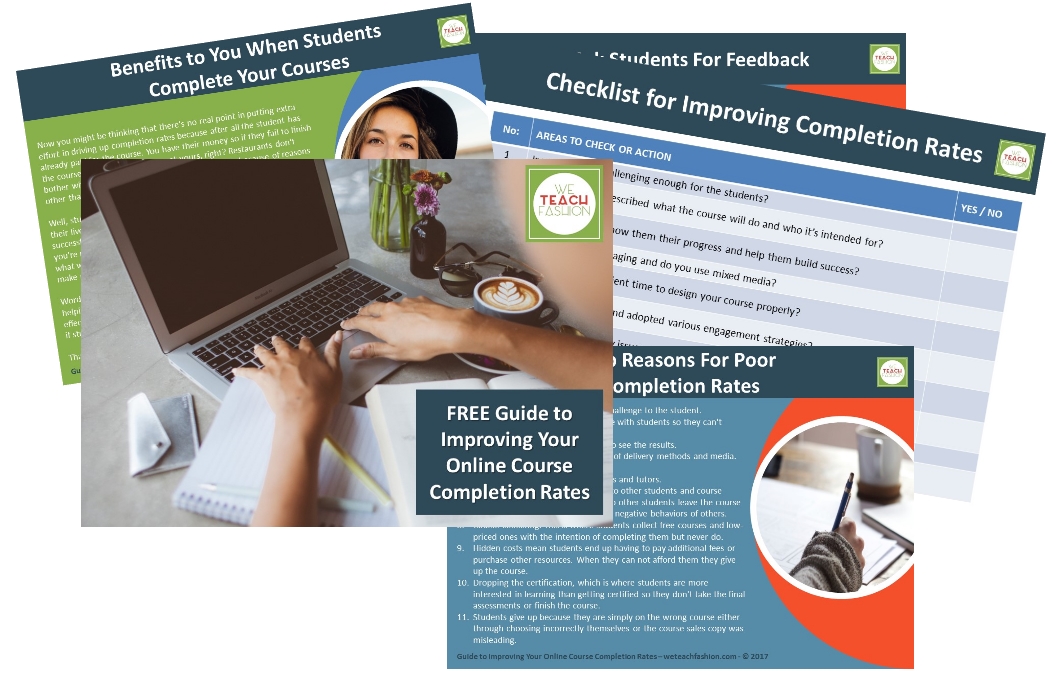10 Ways to Increase the Completion Rates of Your Courses

In this post, we're sharing 10 ways to increase your course completion rates by students. Apply all these techniques, and you'll increase completion. Fact.
Apart from the obvious differences between classroom-based courses and online courses, perhaps the biggest one is the attrition rates. I've trained thousands of adult learners in the private sector, and I am confident that the completion rates on my live classroom courses are close to 100%. That's almost all course participants enrol and complete the course. There's the odd exception where someone doesn't turn up for the second day due to illness or a domestic issue that means they need to return home urgently.
When it comes to online classes, all online learning providers experience much lower completion rates. It's just a fact of doing business online. So why do a higher percentage of students drop out?
Reasons For Low Online Course Completion Rates
- Courses are too easy and offer no challenge to the student.
- Pre-requisite knowledge not in place with students, so they can't progress and give up.
- Courses take too long to complete to see the results.
- Boring lectures and a lack of variety of delivery methods and media.
- Poor course design.
- Lack of interaction between students and tutors.
- Trolls that disrupt courses are rude to other students, and course tutors do not police or take action, so other students leave the course to get away from others' disruption and negative behaviours.
- Course collecting. This is where students collect free courses and low-priced ones to complete them but never do.
- Hidden costs mean students end up having to pay additional fees or purchase other resources. When they can not afford them, they give up the course.
- Dropping the certification is where students are more interested in learning than getting certified, so they don't take the final assessments or finish the course.
- Students give up because they are simply on the wrong course either through choosing themselves incorrectly or the course sales copy was misleading.
So these challenges mean we have to minimise the risk of students failing to complete their courses.
Benefits to You When Students Complete Your Courses
Now you might be thinking that there's no real point in putting extra effort into driving up completion rates because, after all, the student has already paid for the course. You have their money, so if they fail to finish the course, that's their problem, not yours. Restaurants don't bother customers that don't finish their meals because of reasons other than a poor meal. So why bother?
Well, students take your course to get some form of transformation in their lives. A challenge, difficulty or pain will be removed when they complete the course. Unless this transformation occurs, you're never going to get positive student (customer) reviews which is what we all need as tutors to help drive more students to our courses to make more sales.
Word of mouth compliments about how great your course was at helping them improve a skill or resolve a difficulty they had is the most effective marketing form you could wish for. But they'll never happen if students don't complete your course.
That's why our motto is:
"Be Famous for Your Courses"
How to Drive Up Completion Rates for Online Courses
So here are our top 10 ways to improve your online course completion rates.
1. Make Them Challenging
A well-designed course will offer a degree of challenge and difficulty for the student. The activities should stretch them and transform them step by step. If it's not challenging, your students will quickly see there's no point in taking the course because it's not expanding their skills and knowledge.
Having said that, the challenge must come from deliberate design, not sloppy, poor or inconsistent methods.
2. Clearly Communicate What the Course Will Do and Whom It's Intended For
This is important because, without a clear promotional copy, students may take the wrong course. You only want people for whom the course is designed as these are the ones that will find the most benefit. Make sure that your promotional materials, sales page copy etc., clearly explains these details.
3. Show Them Progress and Help Them Build Success
Design your course to help your student achieve the results they want in a logical step by step process. As they progress, help them to see how far they have come and how their work is getting them closer to the success they seek. Have ample reviews so they can appreciate their efforts and progress.

4. Make Your Lessons Engaging and Mix Your Media
It's easy for tutors who go on camera to lose some of their personality and charisma for the first time. Being camera shy affects us all, but with practice comes familiarity, and as you become more at ease, your natural charm will start to shine through. Put effort into your delivery so that you work on engaging students. Adopt an approach of 'edutainment' so that your lessons are both educational and entertaining.
5. Take Time to Design Your Online Course Well
Good design is no accident. It takes a disciplined approach, lots of thought, care and attention. So if you are designing an online course for the first time or are a little rusty and need some guidance, then take a short course and prepare yourself first. Our course called How to DESIGN Your Course With Minimum Effort is the perfect one to take if you want to learn about the DESIGN phase of an online fashion course.
6. Develop Engagement Strategies
This is another area of course design that requires consideration. How are you going to build engagement in your courses deliberately? One way to do this is by offering students support within a group either on Facebook, LinkedIn or another forum hosted on a separate website. Either way, by building a community space for your students to dip in and out of for discussions and interaction, you increase the likelihood that students will complete your course.
7. Tackle Any Trolls Promptly
I've had disruptive students in live classroom events, and I know from experience just how subtle some of their behaviour can be, which leads to a less than perfect experience for their peers. But trolls, whether online or offline, need to be assertively addressed if their behaviour is causing a problem. Make sure you check into your student comment areas frequently, and if you spot anything that is out of line with what you or your students expect, then act.

8. Reward Students When They Complete The Course
Tap into the natural desire we have to be rewarded for progress. You can be creative and offer students that complete your course or sections of it rewards. Brainstorm ideas on what you could offer that would appeal and then use these as incentives. For example, a 1:1 coaching session with you, a discount off a further course, an e-book or paperback, a voucher for a retail store, software subscriptions etc.
9. Adopt the Rule of 10
I try to use the rule of 10 when designing my courses. Have videos no longer than 10 minutes duration, modules with no more than 10 lessons and downloads with no more than 10 pages. There's a reason for this, and that's to make sure that the course is taken in manageable chunks. Also, evidence tells us that the optimal video length for an online course video is 6 minutes or less.
Philip Guo, an assistant professor of Computer Science at the University of Rochester, studied video length with maths and science graduates. You can see his post here.

10. Ask Students For Feedback
Just like businesses use exit interviews when employees leave to identify why the employee is leaving to learn if the root cause lies with the organization, online tutors should use feedback to understand their students' experiences. This is for both when the student completes the course as well as when they don't. Don't forget to ask students who fail to complete your course and why they never completed it. Use an online survey, email or call them. It may have nothing do to with your course, but it may also reveal some great insight into what you can do to improve your completion rates.
If you'd like further support in designing your course, take our signature course or our smaller course called How to DESIGN Your Course With Minimum Effort.
Course Completion Guide and Checklist
If you found this post helpful and would like our free accompanying handout and checklist to ensure you optimise your courses and achieve higher completion rates, then go ahead and download it here.

Mark Gregory is the Founder of The Fashion Student Hub, a marketplace for selling online fashion courses. We Teach Fashion teaching fashion subject experts how to create and promote their own online courses, generate revenue and serve the growing need for online education in the fashion sector.
Join over 1 million people making a living with online courses!
Sign up to get more information about how to teach online, how to pivot your lectures to include online sessions and how to coach students online using the latest technologies.
Get our free training today.
We hate SPAM. We will never sell your information, for any reason.




